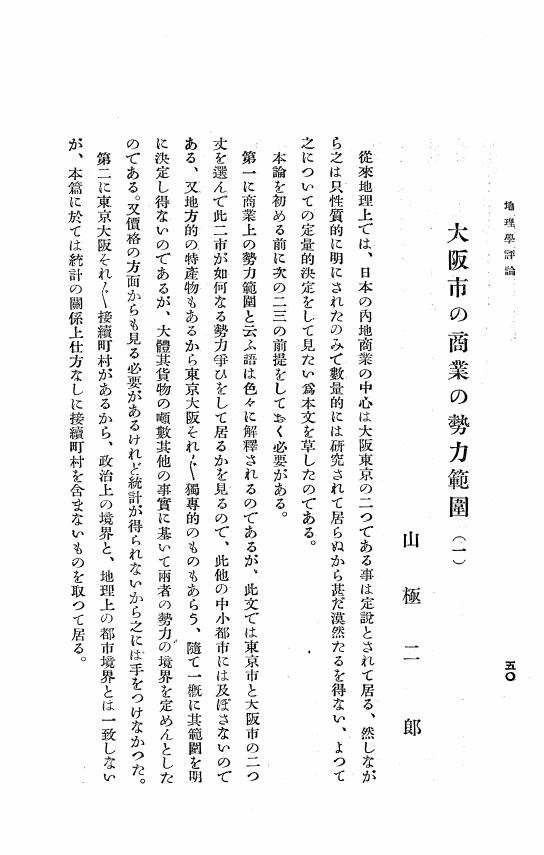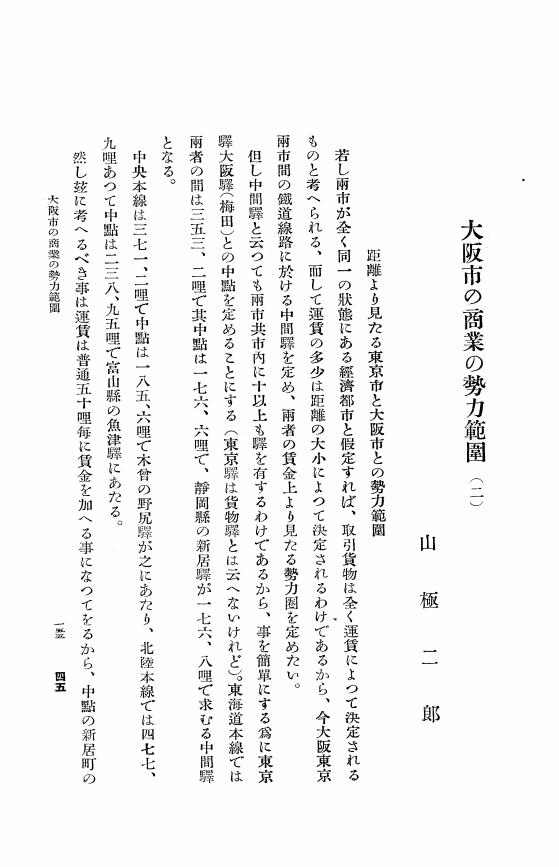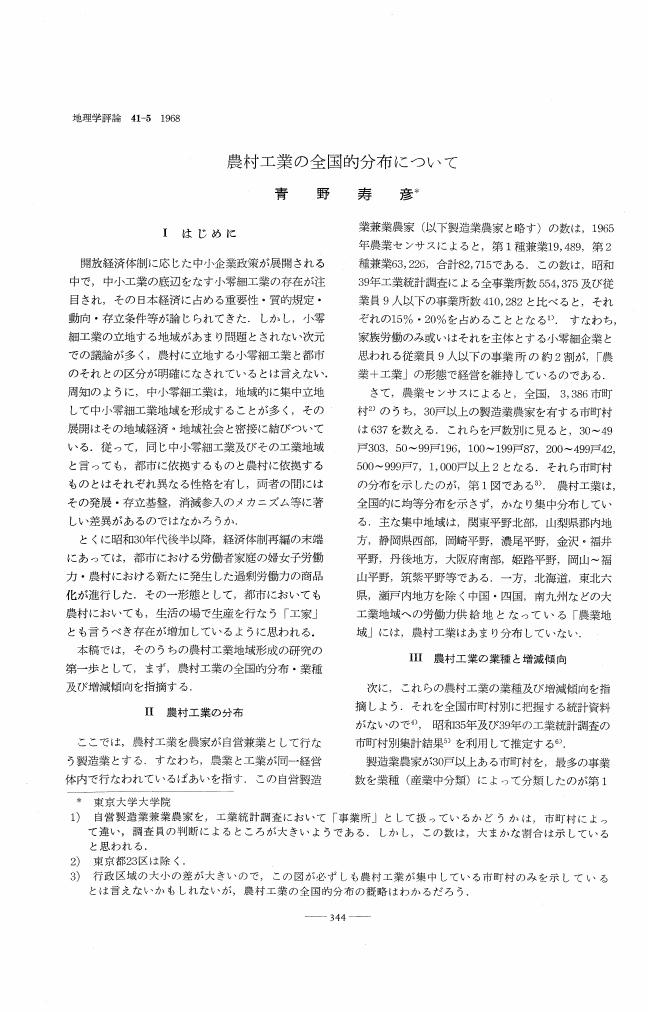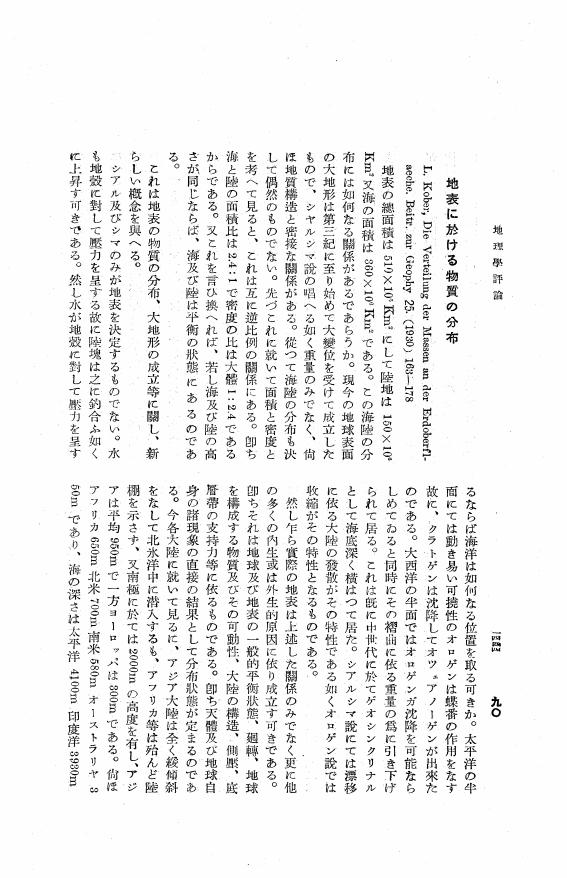2 0 0 0 OA 伊勢志摩地方の地質及び地形から推定される主要なる斷層
- 著者
- 大塚 彌之助
- 出版者
- The Association of Japanese Geographers
- 雑誌
- 地理学評論 (ISSN:00167444)
- 巻号頁・発行日
- vol.4, no.7, pp.649-670, 1928-07-01 (Released:2008-12-24)
- 参考文献数
- 19
- 被引用文献数
- 1
2 0 0 0 OA シンギュラリティに及ぼす太陽黒点数の影響
- 著者
- 長尾 隆
- 出版者
- The Association of Japanese Geographers
- 雑誌
- 地理学評論 (ISSN:00167444)
- 巻号頁・発行日
- vol.33, no.4, pp.219-231, 1960-04-01 (Released:2008-12-24)
- 参考文献数
- 17
年平均の太陽黒点数が変化したとき,シンギユラリティおよびその前後の天気の性質がどうかわるかを, 12月30日, 2月5日, 4月6日のシンギユラリティを例にとつて調べた.調査はLettauの“Specific singularity”の方法に従つて,各暦日の資料を太陽黒点数が60より大きい場合,60と15の間にある場合, 15より小さい場合の3つに層別化した.得られた結果の主なことは次のとおりである. (I) シンギユラリティ当日の天気は太陽黒点数が増加すると,日本内地の雨は全般的に増加するが,減少するときには,日本の南岸を除いて全体として著るしく雨が少い. (II) シンギユラリティの前後の日には太陽黒点数が60より多いときは,九州南部から四国にかけて著るしく雨の少い地域が見られるが,少い日にはむしろ反対の傾向が見られる. これらの結果をもたらす機構は,太陽黒点数の変化により日本付近を通過する高低気圧の数が増減するために起るものであり,このことは各暦日における気温の度数分布の変化からも間接に証明される.
2 0 0 0 OA 大阪市の商業の勢力範圍(一)
- 著者
- 山極 二郎
- 出版者
- The Association of Japanese Geographers
- 雑誌
- 地理学評論 (ISSN:00167444)
- 巻号頁・発行日
- vol.1, no.1, pp.50-61, 1925-03-01 (Released:2008-12-24)
- 被引用文献数
- 1
2 0 0 0 OA 大阪市の商業の勢力範圍(二)
- 著者
- 山極 二郎
- 出版者
- The Association of Japanese Geographers
- 雑誌
- 地理学評論 (ISSN:00167444)
- 巻号頁・発行日
- vol.1, no.2, pp.155-165, 1925-04-01 (Released:2008-12-24)
- 被引用文献数
- 1
2 0 0 0 OA 荒廃河川における侵蝕過程—常願寺川の場合—
- 著者
- 町田 洋
- 出版者
- The Association of Japanese Geographers
- 雑誌
- 地理学評論 (ISSN:00167444)
- 巻号頁・発行日
- vol.35, no.4, pp.157-174, 1962-04-01 (Released:2008-12-24)
- 参考文献数
- 14
- 被引用文献数
- 2 3 15
富山県の常願寺川流域を対象として,過去およそ100年間の侵蝕,堆積とそれによる地形変化の過程を追究した. 1) 常願寺川上流部にある河岸段丘(第2図)は,主として土石流砂礫層から作られており,土石流で埋積された谷がふたたび刻まれて生じたものである.この土石流砂礫層は, 1858年の「大鳶崩れ」といわれる変災時の絵図記録を検討してみると,このときに発生した大土石流の堆積物である. 2) 1858年の土石流は,地震のために源流部の立山カルデラの一部(鳶崩れと本文で呼んだ部分)が大規模に崩れて生じたもので,下流部の扇状地,三角州まで流下形態をほとんど変えずに流下した・しかし土石流の主要な部分は上流部(海抜550m以上の部分)にとどまり,谷を深く埋めた.このため埋積谷の縦断形の傾斜は増した. 3) 1858年の変災以後,崩壊地から供給される岩屑が少なくなるにつれて,埋積谷の侵蝕は,上流部,とくに,谷の合流により流量がかなり増し,しかも河床傾斜の大きい部分から始まつた.崩壊地から4km以下の高位段丘で,土石流砂礫層の上にのり,やや円磨され,成層した砂礫層はこの開析初期の土石流砂礫層の2次的堆積物である.この上流の部分から始まつた下方侵蝕はさらに上流へ谷頭を後退させたばかりでなく,下流へも進行した.回春谷の上流部の河床は土石流の堆積直後から急速に低下し,下流部の河床は一時2次的堆積物によつて上昇した後に,相対的にはゆつくりと低下した. 4) 1858年に発生した土石堆積物の量はおよそ4.1×108m3,それ以後100年間の侵蝕物の量はおよそ2.1×108m3,このうち約10%が扇状地に堆積し,天井川を作つた. 5) 常願寺川における過去100年間の,山地の大崩壊を契機とする谷の侵蝕は,谷底部の著しい地形変化をひき起して,急速に進んだ.そしてこのことがこの川の砂防を難しくした.
2 0 0 0 OA 最近の地質時代に於ける丹那斷層の運動に就いて
- 著者
- 久野 久
- 出版者
- The Association of Japanese Geographers
- 雑誌
- 地理学評論 (ISSN:00167444)
- 巻号頁・発行日
- vol.12, no.1, pp.18-32, 1936-01-01 (Released:2008-12-24)
- 参考文献数
- 3
洪積期の初期多賀火山・湯河原火山の斜面が形成され,地殻運動によつて此斜面上に隆起部(玄岳一池〓山峠附近)と沈降部(田代・丹那盆地)とを生じ,斜面上には谷系も出現した後,丹那斷〓の著しい活動が起つた。そして斷〓を境にして其の西側の地塊が東側地塊に對し南方に役1粁水平移動をなし,且つ池ノ山峠附近では東側地塊に對しさらに役100米〓の隆起運動を行つた。丹那斷〓は丹那盆地の盆地地形成因の重要な要素ではない。同盆地は多賀火山斜面が楕圓形に沈降して生じた構造盆地である。丹那斷〓は此盆地の中央を横ぎつて生じ,盆地の外形を稍複雑なものにしたに過ぎない。
2 0 0 0 OA 近江に於ける宮座の考察
- 著者
- 千葉 徳爾
- 出版者
- 公益社団法人 日本地理学会
- 雑誌
- 地理学評論 (ISSN:00167444)
- 巻号頁・発行日
- vol.20, no.4, pp.209-217, 1944-05-01 (Released:2008-12-24)
- 参考文献数
- 8
2 0 0 0 OA 宮座の周邊
- 著者
- 千葉 徳爾
- 出版者
- The Association of Japanese Geographers
- 雑誌
- 地理学評論 (ISSN:00167444)
- 巻号頁・発行日
- vol.18, no.8, pp.679-681, 1942-08-01 (Released:2008-12-24)
2 0 0 0 東急多摩田園都市における住宅地形成
- 著者
- 松原 宏
- 出版者
- 日本地理学会 古今書院(発売)
- 雑誌
- 地理学評論 (ISSN:00167444)
- 巻号頁・発行日
- vol.55, no.3, pp.p165-183, 1982-03
2 0 0 0 衛星都市としての浦和の機能--大都市圏の拡大に伴う地方都市の変質
- 著者
- 山鹿 誠次
- 出版者
- 日本地理学会 古今書院(発売)
- 雑誌
- 地理学評論 (ISSN:00167444)
- 巻号頁・発行日
- vol.24, no.8, pp.283-289, 1951-08
1 0 0 0 OA 能登半島の海成段丘とその変形
- 著者
- 太田 陽子 平川 一臣
- 出版者
- The Association of Japanese Geographers
- 雑誌
- 地理学評論 (ISSN:00167444)
- 巻号頁・発行日
- vol.52, no.4, pp.169-189, 1979-04-01 (Released:2008-12-24)
- 参考文献数
- 32
- 被引用文献数
- 17 9
能登半島の海成段丘を調査して,第四紀中・後期における古地理の推移と地殻変動を考察した.能登半島の海成段丘は,高位からT, H, M, Lの4群に大別され,さらにTは7段,Hは4段,Mは3段に細分される.M1面は最も連続的に分布し,貝化石と海進を示す厚い堆積物とを伴う広い面で,最終間氷期の海進(下末吉海進)に形成されたと考えられる.M1面より高位に約10段もの海成段丘があるので,その分布から,能登半島の大部分が更新世中期以降の離水によって生じたものであるとみられる.M1面の旧汀線高度ば北端の110mから南部の20mまで,全体として南下り,富山湾側への緩い低下を伴う傾動が推定される.しかし,半島全体が一つの傾動地塊をなすのではなく,1辺10~20km,それぞれが南下りの傾動を示す数個の小地塊の集合からなっている.M1面とそれより古期の段丘の傾動の量はほぼ等しいので,各地塊の傾動はM1面形成後に活発になったと考えられる.北端部での平均隆起速度は1m/1,000年となる.
1 0 0 0 OA 構造論的に觀たる能登と佐渡
- 著者
- 望月 勝海
- 出版者
- The Association of Japanese Geographers
- 雑誌
- 地理学評論 (ISSN:00167444)
- 巻号頁・発行日
- vol.8, no.3, pp.171-195, 1932-03-01 (Released:2008-12-24)
- 参考文献数
- 15
The so-called Honshu arc, the main part of Japan, was formed as the result of a ‘peri-Japan-Sea’ tectonic movement. The arc is divided geologically into two parts north-eastern and south-western Japan, by a line drawn from Itoigawa to Shizuoka. The Noto Peninsula and Sado Island, which are similar in form and on the concave side of the arc, were both elevated by this movement. At the eastern end of South-Eastern Japan, we observe several mountain ranges arranged en échelon. The uplift of the Kaga-Mino range extends northwards and joining that of the peri-Japan-Sea movement, formed the great Noto Peninsula. At Sado Island, however, the two blocks that compose the island were elevated parallel with the tectonic features of the main part of the Honshû arc. Therefore Sado has remained an island. In consequence of periodical uplifts of land, a step-like topography is developed extensively in the two districts. These steps are wider on the peninsula than on the island, but are at higher levels on the island than on the peninsula.
1 0 0 0 OA 能登半島邑知地溝
- 著者
- 大塚 彌之助
- 出版者
- The Association of Japanese Geographers
- 雑誌
- 地理学評論 (ISSN:00167444)
- 巻号頁・発行日
- vol.10, no.8, pp.645-670, 1934-08-01 (Released:2008-12-24)
- 参考文献数
- 15
- 被引用文献数
- 1 1
This paper will be published in English in the Bull. Earthquake Research Institute, Imp. Univ. Tokyo, at no distant date.
1 0 0 0 OA 大佐渡沿岸の海岸段丘
- 著者
- 太田 陽子
- 出版者
- The Association of Japanese Geographers
- 雑誌
- 地理学評論 (ISSN:00167444)
- 巻号頁・発行日
- vol.37, no.5, pp.226-242, 1964-05-01 (Released:2008-12-24)
- 参考文献数
- 11
- 被引用文献数
- 5 4
大佐渡沿岸には数段の海岸段丘が発達しており,それらは高度,連続性などから第1段丘 (160~220m), 第2段丘 (80~140m), 第3段丘 (60~120m), 第4段丘 (35~70m), 第5段丘 (25~40m) および第6段丘 (5~8m) の6段に大別される.とくに,二見半島から大佐渡西岸には発達が顕著であるが,東岸にはきわめて断片的に小平坦面として分布するにすぎない.これらの中で第3, 第4段丘はほぼ全域に巾広く,また第6段丘は狭いが島全体をとりまいて分布する.段丘面の性質は地域によりかなり異なっている.すなわち,西岸ではおもに外洋における海蝕作用による海成段丘として,真野湾沿岸ではやや内湾的な場所で多少堆積作用も働いた結果の海成段丘として形成された.東岸では,急崖下の小規模なおし出し状隆起扇状地の性格をもつ所が多い.国中平野では,第2, 第3段丘は金北山下の斜面を流下する諸河川によって堆積された隆起扇状地であるが,第4段丘は,比較的厚い浅海堆積層の堆積面として形成された.なお第6段丘は全地域において海成段丘であり,温暖な fauna を含む厚い海成冲積層からなる国中平野の冲積面に続いており,日本各地で認められている冲積世初期の海進に基く地形であろう.第4段丘は冲積世海進前の海面低下期に先立つ比較的明瞭な海進期に形成されたものと思われる. 段丘面の性質の地域的差異を生じた原因は,西が緩やかで東が急斜面をもっという大佐渡の非対称な地形と,西側が外洋に面し,国中平野側が内湾的であったというような,後背地の地形および前面の海況などがおもなものであったと考えられる.このように,背後の地形や海況に著しい差異がある所では,岩石的制約は,火山岩地域などのような抵抗性の大きい岩石地域における段丘面上の stack の存在などとして現われてはいるが,段丘の形成には二次的な意味をもつにすぎないと思われる. 段丘の高度は,東西方向では大きな差異はみられないが,南北方向では島の両端から中央部に向って高くなり,しかも古い段丘ほどその傾向が著しい.おそらく第1段丘形成時(あるいはその前から)から島の中央部に軸をもつ撓曲的性格の上昇運動がつづき,その間に全域にわたる海面変化が繰返されて現在のような段丘の配列をみたのであろう.地殻運動と海面変化との関係についてはまだわからないが,少なくとも段丘面の高度の地域的変化を生じた原因は上述の示差的な地殼運動であるらしい.
1 0 0 0 OA 気候地域の設定-その思潮と問題
- 著者
- 矢澤 大二
- 出版者
- The Association of Japanese Geographers
- 雑誌
- 地理学評論 (ISSN:00167444)
- 巻号頁・発行日
- vol.53, no.6, pp.357-374, 1980-06-01 (Released:2008-12-24)
- 参考文献数
- 154
- 被引用文献数
- 1 1
Many theories of climatic classification and of division of climatic regions of the world have been presented in general books on climatology and on physical geography. However, few reports trace the current of thoughts synthetically from the very root of studies up to the present. In the present paper the author has an object to follow the development of thoughts successively and point out how the thoughts of significance had been exploited and developed further. This paper consists of three parts ; namely, an examination of effective methods, a discussion of the problem of humid and arid boundary, and an examination of genetic methods. Effective methods since the 1840's are examined. Some earlier works by Hult, Supan, Köppen, de Martonne, Philipsson etc. were followed by several modern works by Blair, Trewartha, Creutzburg Troll, etc. Special attention is paid to make clear the current of thoughts, regarding representative standards for clamatic classification and for objective divisions into climatic regions. Then, the problem of the boundary between humid and arid regions are reviewed and examined. The concept of effective humidity originated in Linssers's earlier work has been developed by various successors, in order to make clear the water budget or the limit of arid region, indirectly. Physiogeographic consideration by A. Penck was a pioneer work of importance. After genealogic consideration of various methods for evaluating aridity of climate (indices such as Regenfaktor, indice d'aridité, quotient pluviothermique, precipitation effectiveness etc.) and their applicability to distinguish humid and arid climates, the author examines concisely the approach to the rational classification of climate introduced by Thornthwaite, and developed by his successors. It is also pointed out that there are two currents of thoughts regarding the main division of climatic regions of the world. One is to divide, except for the polar region, the world into humid and arid regions, then to subdivide the former into thermal zones and the latter into regions depending upon the degree of aridity. The other is, on the contrary, to divide the world into several thermal zones, and then to subdivide them into subregions, based upon the degree of aridity or humidity of climate. The standpoint of these approachs, therefore, are different to each other. Finally, genetic methods of classification of climate and their applicability to the presentation of climatic regions are examined. The root of such a current could be found in the early works on wind systems or windregions of the world introduced by Mühry, Wojeikof, Köppen, Hettner etc. during the latter half of the last century and the first half of this
1 0 0 0 OA 農村工業の全国的分布について
- 著者
- 青野 寿彦
- 出版者
- The Association of Japanese Geographers
- 雑誌
- 地理学評論 (ISSN:00167444)
- 巻号頁・発行日
- vol.41, no.5, pp.344-349, 1968-05-01 (Released:2008-12-24)
- 参考文献数
- 8
1 0 0 0 OA 日本における水文学の発達
- 著者
- 山本 荘毅
- 出版者
- The Association of Japanese Geographers
- 雑誌
- 地理学評論 (ISSN:00167444)
- 巻号頁・発行日
- vol.51, no.7, pp.517-527, 1978-07-01 (Released:2008-12-24)
- 参考文献数
- 90
- 被引用文献数
- 1
The author summarized a history of development of groundwater hydrology in Japan. In general, the historical development of hydrology can be viewed through a series of periods and through series of events and articles such as number of books, papers and theories related to groundwater studies. Correlating to the historical division of Chow, Ven Te and that of Hida, N. et al., he proposed the division of development of groundwater hydrology in Japan as follows: a) Period of noninterference study (_??_1940), I-II1 b) Period of study of researcher's own free will ('40_??_'50), II2 c) Period of study under governmental readerships ('50_??_'55), II3 d) Period of cooperation with government and researcher ('55_??_'60), II3 e) Period of independant and free study ('60_??_date), IIISince these periods may overlap, their time division should not be considered exact. Generally speaking, all stages correspond to that of Chow's but those begin on about ten years later than those of western one. He tried to explain such a stage of development by political and socio-economic situations and stimulation of UNESCO's IHD. Because groundwater science is an interdisciplinal and practical science for needs of water resources in a country. Finally, he pointed out present problems of modern groundwater sciences on data with regards to accurracy, collection and coordinations, terminology and its redefinition, and groundwater law in Japan.
1 0 0 0 OA 地表に於ける物質の分布
- 著者
- 淡路 正三
- 出版者
- The Association of Japanese Geographers
- 雑誌
- 地理学評論 (ISSN:00167444)
- 巻号頁・発行日
- vol.6, no.9, pp.1444-1446, 1930-09-01 (Released:2008-12-24)
1 0 0 0 OA 渋谷繁華街の構造
- 著者
- 松沢 光雄
- 出版者
- The Association of Japanese Geographers
- 雑誌
- 地理学評論 (ISSN:00167444)
- 巻号頁・発行日
- vol.39, no.9, pp.618-624, 1966-09-01 (Released:2008-12-24)
- 参考文献数
- 1
- 被引用文献数
- 2
(1) 渋谷繁華街を繁華街核心域(中心回遊路・回遊路内包域),回遊路外接域,周縁域の3地域に区分する. (2) 副都心を形成する新宿・渋谷・池袋の繁華街の構造上の共通点から,副都心構造の類型を導きだすことを試みた・しかし,副都心とよぼれる繁華街は,その数が少なく9特殊的事象と類型的事象との区別が困難である場合が多い.また,これら繁華街の構造および規模は,時代の経済事情に影響され装身具の流行(毛皮店)や,遊戯内容の変化等(トルコ風呂,スーパーマーケット,つり堀,レーシングカーなどの消長)の条件に反応すると思われる点もあって,固定的解釈をもつことは困難である.しかし,出来る限り,類型性をもつものを整理するようつとめた. (3) 繁華街構造の研究は,人間の快楽的要求と集落構造との関係の研究に外ならず,従って,心理学的立場からの考察が必要であるが,本論ではその面にはふれなかった.
1 0 0 0 OA 八ケ岳西麓原村における灌漑水利慣行の形成と新田開発(その1)
- 著者
- 五味 武臣
- 出版者
- The Association of Japanese Geographers
- 雑誌
- 地理学評論 (ISSN:00167444)
- 巻号頁・発行日
- vol.45, no.7, pp.484-490, 1972-07-01 (Released:2008-12-24)
- 参考文献数
- 27







